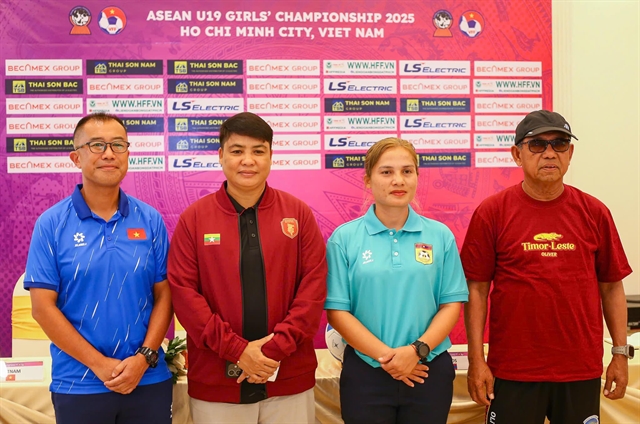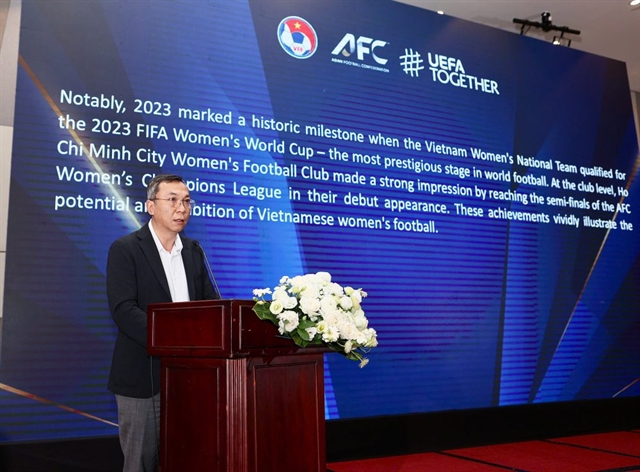 Sports
Sports

Football
 |
| Việt Nam Football Federation President Trần Quốc Tuấn speaks at the launching ceremony of the Việt Nam Women's Football Development Strategy on June 6 in Hà Nội. Photos courtesy of VFF |
HÀ NỘI – The Việt Nam Football Federation (VFF) officially launched a comprehensive strategy to accelerate the development of national women’s football on June 6 in Hà Nội.
The Việt Nam Women’s Football Development Strategy falls under the broader framework of the Women’s Football Development Project, supported by both the Union of European Football Associations (UEFA) and the Asian Football Confederation (AFC) for the 2024–2027 period.
Since entering the international stage in 1997, Vietnamese women’s football has recorded a series of impressive accomplishments. These include eight SEA Games gold medals, reaching the quarter-finals of the 2018 Asian Games, securing a spot in the 2022 AFC Women’s Asian Cup finals, and most notably, qualifying for the FIFA Women’s World Cup for the first time in 2023.
At the club level, HCM City Women’s Football Club made headlines with their strong debut in the AFC Women’s Champions League, advancing to the semi-finals and showcasing the growing strength of domestic teams.
National senior and youth-level women’s tournaments have also seen significant growth, laying a solid foundation for the development of the national squads.
However, the VFF emphasised that to transition towards a professional, competitive, and sustainable women’s football ecosystem, a long-term strategic vision is essential.
 |
| National players are training in Hà Nội for the AFC Asian Cup 2026 qualification. |
“From 2024, the Việt Nam Football Federation has officially embarked on a new chapter in the development of national women’s football. This project is not only a strategic milestone but also a reaffirmation of our commitment to enhancing the quality of the women’s game, with the goal of raising its status in Asia and bringing it closer to elite global competitions,” said VFF President Trần Quốc Tuấn.
“Since officially entering the international women’s football arena in 1997, Việt Nam has achieved many remarkable milestones. The domestic competition system has steadily expanded, especially with the introduction of youth tournaments and the National Cup, providing players with valuable match experience and opportunities to develop their skills.
“Our youth women’s teams have received significant investment and attention, with many opportunities created for them to train in countries where women’s football is well-developed.”
"These achievements vividly illustrate the potential and ambition of Vietnamese women's football. However, to sustain momentum and advance towards professionalism – an essential goal for any developing football nation – we require a comprehensive, well-structured, and consistently executed strategy.
"We firmly believe that women's football is not just 90 minutes on the pitch but a journey of value affirmation, inspiration, resilience, and the pursuit of limitless ambitions," said Tuấn.
He believed that under strong support of local and international partners and organisations, Vietnamese women's football would continue to thrive, maintain its position in the region, and advance further on the global football map.
Among the targets of the strategy are building a holistic women's football ecosystem – from school-level grassroots programmes to international competitions; creating opportunities to play football for female students; organising training courses for female coaches and referees, building brand for the women's football; and mobilising more sponsorship and support to elevate Vietnamese women's football on the global stage.
Speaking at the event, Simon Toselli, FIFA women's football technical expert, appreciated VFF's strong efforts, interest and dedication in developing women's football in Việt Nam.
 |
| FIFA women's football technical expert Simon Toselli praises Việt Nam's effort and plans for women's football development. |
He said one of FIFA’s top priorities was to ensure that each member association had a dedicated strategy for the development of women’s football. Such a strategy would guide the sport’s growth, provide a clear roadmap, and, most importantly, define specific goals along with practical actions to achieve them.
He congratulated the VFF on introducing an ambitious and realistic strategy that would not only advance Vietnamese women’s football but also create new opportunities for girls and women—both on the pitch and in society—and empower the next generation. VNS









